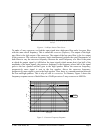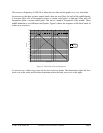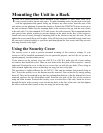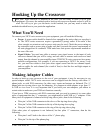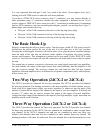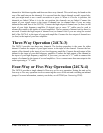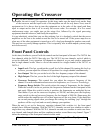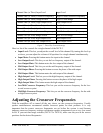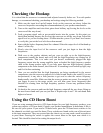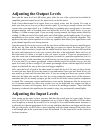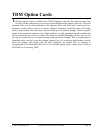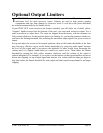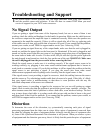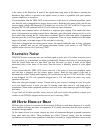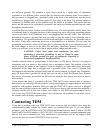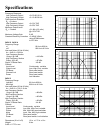
© 2003 TDM Audio, Inc. Electronic Crossover Owner’s Manual Page 20
Troubleshooting and Support
his section details various problems that you might encounter when using your crossover,
and the possible causes and solutions. It also tells how to contact TDM when you need
service or support for your 24CX series crossover.
No Signal Output
If you are getting a signal from some of the frequency bands, but one or more of them is not
working, check the cables and hookups for the band(s) in question. Make sure the cable between
the crossover output and the amplifier input is connected correctly. Make sure the speakers are
connected to the amplifier correctly. If there is still no signal after all of this, try replacing each
of the cables one at a time with a cable that is known to be good. If you cannot find the problem,
contact your vendor, or call TDM for support and/or service (see Contacting TDM).
If you are getting no signal from any of the output bands, make sure that the unit is plugged in,
turned on, and that the power light on the front panel is illuminated. If the unit is plugged in and
turned on, but the power light does not come on, try plugging some other piece of equipment into
the same outlet to make sure it works. If it does work, but you still don’t get the power light with
the unit plugged in and turned on, check the fuse on the rear of the unit. WARNING: Make sure
the unit is unplugged from the power outlet before removing the fuse!
Check the signal source to make sure it is working correctly. If the signal source seems to be
working correctly, try plugging it into some sound reinforcement equipment that is known to
work (such as a monitor system). If you do this and there is still no signal, the problem is that the
signal source is not providing a signal. If you plug the source into some other sound
reinforcement equipment and everything works correctly, then the signal source is fine.
If the signal source is not providing a signal to crossover, check the cabling between the source
and the crossover. Try substituting another cable that is known to be good. If this fails, it’s likely
that your signal source is malfunctioning, or that there is some problem with the way the
individual components of the source are connected.
If the signal source is providing a signal to the crossover, but you are still getting no output
signal, check to make sure that the problem is not with the power amps, speakers, or cables. The
most common cause this kind of problem is either a bad cable, or an incorrect hookup. The best
way to trace down a bad cable is to replace each cable in turn with one that is know to be good
and then check if that fixed the problem. If you cannot find the problem, contact your vendor, or
call TDM for support and/or service (see Contacting TDM).
Distortion
To determine the cause of the distortion, try systematically removing each piece of signal
processing equipment from the chain, one at a time. After a piece of equipment is removed from
the chain (by plugging the piece of equipment before it directly into the piece of equipment after
it), listen to the system and determine if the distortion is still present. When you remove a piece
of equipment and the distortion goes away, then it is likely that this particular piece of equipment
T



